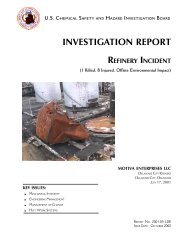CTA Report, Draft 1, ISP Review - US Chemical Safety and Hazard ...
CTA Report, Draft 1, ISP Review - US Chemical Safety and Hazard ...
CTA Report, Draft 1, ISP Review - US Chemical Safety and Hazard ...
Create successful ePaper yourself
Turn your PDF publications into a flip-book with our unique Google optimized e-Paper software.
<strong>CTA</strong> department supervisors were responsible for providing employees with information on the physical<br />
<strong>and</strong> health hazards of specific chemicals in each work area. Interviews with supervisors <strong>and</strong> employees<br />
revealed that crew safety meetings did not address the explosive hazards of phenolic resin. <strong>CTA</strong> did not<br />
provide records to CSB documenting the content of supervisor-led training.<br />
8.4 Facility Design <strong>and</strong> Construction<br />
Lockwood Greene Engineers, Inc. designed <strong>and</strong> constructed the Corbin facility for CertainTeed in 1972.<br />
FM Global (formerly Factory Mutual) was consulted by CertainTeed to review preliminary process<br />
design drawings, which the company found to be acceptable.<br />
CertainTeed intended to use plastic resins that were combustible dusts. During design <strong>and</strong> construction,<br />
CertainTeed <strong>and</strong> Lockwood Greene could have used NFPA 654, Dust Explosion Prevention in the<br />
Plastics Industry (1970), to minimize potential combustible dust hazards. Although this earlier version of<br />
the st<strong>and</strong>ard was only applicable to the plastics industry, not to operations like CertainTeed’s, 22 it was<br />
issued as a guide to eliminate or reduce dust explosion hazards (in this case, those that are inherent in the<br />
manufacture, fabrication, molding, <strong>and</strong> h<strong>and</strong>ling of plastics). In 1976, NFPA exp<strong>and</strong>ed the scope of the<br />
st<strong>and</strong>ard to include chemical, dye, <strong>and</strong> pharmaceutical dusts, but a new edition of the st<strong>and</strong>ard was not<br />
issued until 1982. The organization revised the st<strong>and</strong>ard again in 1997 to include all industries where<br />
manufacture, processing, blending, repackaging, <strong>and</strong> h<strong>and</strong>ling of combustible dusts presented a fire or<br />
explosion hazard.<br />
The 1970 version of NFPA 654 recommended separate, detached buildings for processing <strong>and</strong> h<strong>and</strong>ling<br />
combustible dusts. For processes that could not be detached, NFPA 654 required segregation to minimize<br />
22 CertainTeed did not consider itself a member of the plastics industry based upon its st<strong>and</strong>ard industrial<br />
classification code.<br />
71









